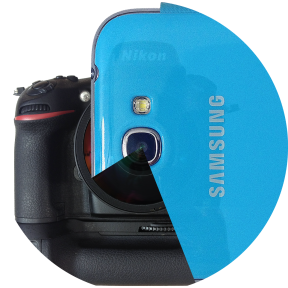For photos, would you trade your SLR for a smartphone?
According to the WSJ article by J. Osawa, declining sales of DSLRs and lenses are signaling that the market as a whole is doing just that. Conventional wisdom would suggest that while camera-phones could compete with basic compacts, surely DSLRs with their huge  sensors and interchangeable lenses would be safe.
sensors and interchangeable lenses would be safe.
Yet market data does not lie – those sales figures are what they are. What I believe is happening is the rules of the game (of delivering cameras that the market wants) just got changed. DSLRs still win hands-down at the old game (quality, performnce, control), but that is quickly becoming only a part of what makes a good camera.
What’s the other part? Editing and connectivity. Today’s reality is, people want the best shots, with basic post-processing, to be up online right now. Instagram gets you there in 10 seconds, and if you invent something that gets you there in 5, you will kill Instagram. Smartphones’ full-time internet connectivity and their processing power that can be brought to bear in 3rd party photography apps, put together, is a game changer.
If DSLR manufacturers want to keep selling to amateurs, enthusiasts, as well as pros in many fields, they need their DSLRs’ internet and app capability to match that of the smartphones. SONY DSC-QX100 which is basically a high quality sensor and lens that communicates with a smartphone via WiFi and NFC and can clip onto it, is the writing on the wall. WiFi-enabled memory cards or dongles, and camera-smartphone hybrids, are other vectors aiming at the same ultimate solution. Perhaps we’ll see SIM card slots next to memory slots in future DSLRs, backed by lifetime unlimited data plans.
The next few years will be very transformative for SLRs, I believe. One thing we can all count on is, good photos will still be good, among the abundance of of bad ones. We’ll just be seeing them all a lot sooner. And that, as always, will have been a sign of the times.
Corollary: two additional factors may be undermining sales of DSLRs and lenses:
1) Mirrorless interchangeable lens cameras have introduced a plethora of new mounts. Which ones are dead ends and which are winners, nobody knows, so users end up with mount fatigue and simply sit on the fence, continuing to use whatever they already have.
2) Manufacturers’ aggressive popularization of the notion that new sensors need new lenses and old analog lenses are no good on digital, while successful in the short-term to drive up sales, is finally starting to back-fire. In the old days, advanced amateurs and pros were comfortable with the idea of picking a mount/system and gradually investing in a sizable lens inventory that facilitated lots of interesting photography. Given the notion that lenses have inherent obsolescence, buyers today are understandably more skittish to over-invest.
It’s not necessarily a matter of sitting on the fence.
For the average birthday, holiday and kids sports snap shotter the entry level DSLR they bought 2 years ago still works perfectly well.
Yeah, they might be better off with a faster lens.
But Nikon and Canon won’t sell them a fast zoom for under $1200-1500.
And those 1-2 stops are not woth $1200-1500 to those users.
A decent flash might appeal too. But again $400 for a flash. Really?
To make your $500 DSLR usuable in the places you’d like to use you need to spend another $1500-2000?
How ’bout Canikon knock out a kit quality fast standard zoom. 17-55 ƒ2.8 VR for say $650.
Tamron and Sigma can do it, and they have to reverse engineer the mount protocols for 4 or 5 different mounts.
How come Canikon can’t do it with the home plate advantage.
All those D3000s, D3100s, D5000s, D5100s etc etc – all of those cameras are still working as well as they ever did for their owners.
There is no need to replace them.
There may well be an advantage to upgrading them – but Canikon won’t see most of those sales, because they can’t bring themselves to drop their margins to raise the volume and stay alive.
What’s more by making accessories affordable you’ll keep some people interested in photography, that would otherwise give up, after they realise how expensive it is.
Dead man walking!
JT, valid points!
I think there’s, ironically, a similarity between DSLR and smartphone pricing. Just like smartphones in the U.S. are often priced below cost and the makers recover their money over time from the carriers, manufacturers price DSLRs very aggressively as they know this is what consumers chiefly price-match.
Very few of us would go through the trouble of computing and comparing system-wide TCO (total cost of ownership). This is why we see $2500 full frame bodies (likely discounted) and $40 lens caps (likely marked up). Question is, would we be happier if everything were priced in line with its costs? It would make some low-volume, high tech items quite inaccessible.